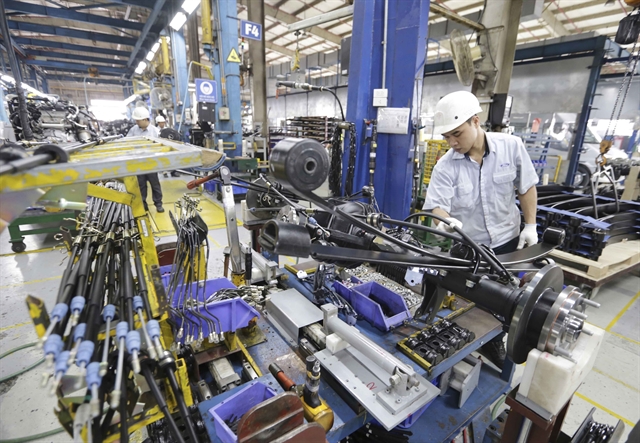 Economy
Economy


|
| An automobile factory in Hải Dương Province. WB said industrial production in October grew by 6.3 per cent year-on-year. VNA/VNS Photo |
HÀ NỘI — Việt Nam's industrial production and retail sales grew at a slower pace in October as a result of weakening demand at home and abroad, according to the World Bank (WB).
In its recently-published Vietnam Macro Monitoring report, WB said industrial production in October grew by 6.3 per cent year-on-year, lower than the figure of 13 per cent in September.
The low growth rate can be attributed partly to the diminishing low-base effect and predominantly to the shrinking demand from overseas, caused by the slowing down of the EU, US and Chinese economies.
The same goes for retail sales, which grew by 17.1 per cent year-on-year, against the figure of 36.1 per cent in September. Sales of consumer services registered a stronger growth rate than sales of goods, with 12 per cent for the former and 9.6 per cent for the latter.
Despite a trade surplus of US$2.3 billion, export growth rate moderated from 10.3 per cent to 4.8 per cent last month. Imports, meanwhile, accelerated with a growth rate of 7.1 per cent, reflecting the rebound in imported electronics and machines.
Inflation, measured by Consumer Price Index, rose from 3.9 per cent in September to 4.3 per cent in October, slightly overshooting the target of 4 per cent set by the State Bank of Vietnam (SBV).
Transport was no longer a major contributor to inflation thanks to softening fuel prices, which were down 6 per cent year-on-year. Instead, the mounting inflation was driven by a rise of 5 per cent in food prices, the highest rate since December 2020.
In foreign investment, total registered capital jumped to $3.7 billion, 122 per cent higher than the figure in October 2021. The boom was a result of the accelerating investments in large-scale facilities in electricity, gas and water supply.
After reaching a height of 16.9 per cent in September, credit growth declined to 16.5 per cent in the following month by reason of SBV's contractionary stance. Specifically, the bank lifted policy rates by 200 basis points during the period, causing average overnight interbank rates to increase from 4.9 per cent in September to 5.8 per cent in October.
Amid the tightening of global financial conditions and the strengthening of the US dollar, the VNĐ/USD exchange rate continued to depreciate in October. By November 3, the Vietnamese đồng has weakened by 9.1 per cent against the greenback since early in the year.
The budget balance posted a slight surplus of $200 million in October, against a deficit of $500 million in the previous month. Total fiscal revenues fell by 6.7 year-by-year whereas total expenditures rose by 11.8 per cent. Public disbursement, meanwhile, reached 56.6 per cent of the plan approved by the National Assembly.
With the budget balance in surplus, the State Treasury issued just $1 billion worth of local-currency-denominated government bonds in October, all of which had long maturities. Total ten-month bond issuance reached 34.9 per cent of the annual plan.
As the US Federal Reserve is expected to continue its rate hikes, WB suggests a more flexible approach to Việt Nam's exchange rate policy to allow reference exchange rates increasing at a faster pace.
WB also said direct sales of foreign currency to stabilise exchange rates should be used wisely to preserve vital foreign reserves. Coordination of monentary and fiscal polices is essential for the time being to ensure price stability amid the mounting inflation. — VNS




